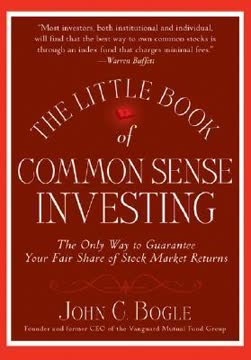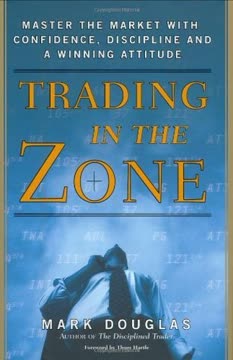Key Takeaways
1. Invest for Capital Appreciation, Not Income
Any earner who earns more than he can spend is automatically an investor. It doesn't matter in the slightest whether he wants to be or not, or even whether he realizes that he is investing.
Capital appreciation is key. Focusing solely on income from investments can be a misguided strategy. Instead, investors should prioritize total return, which includes both income and capital appreciation. This approach allows for greater flexibility and potentially higher returns over time.
Consider growth potential. When evaluating investments, look beyond current dividend yields or interest rates. Assess the potential for future growth in earnings and asset value. Companies reinvesting profits for expansion or research and development may offer better long-term prospects than those paying high dividends.
Balance risk and reward. While seeking capital appreciation often involves higher risk, it also offers the potential for greater rewards. Diversify your portfolio to manage risk, but don't shy away from growth-oriented investments that align with your financial goals and risk tolerance.
2. Focus on Liquid, Listed Securities for Better Results
I think it would be very difficult for an investor losing, say, 5% to 10% each time on a succession of ventures, to continue to lose time and time again without checking his errors or stopping altogether.
Liquidity matters. Investing in highly liquid, listed securities provides several advantages:
- Easy buying and selling
- Transparent pricing
- Lower transaction costs
- Better information availability
Avoid illiquid investments. Unlisted or thinly traded securities can be challenging to value and sell, potentially leading to significant losses or missed opportunities.
Monitor your investments. Liquid markets allow for frequent portfolio evaluation and adjustment. This flexibility enables investors to respond quickly to changing market conditions or new information.
3. Understand Market Psychology and Technical Analysis
Nothing is more difficult, I truly believe, than consistently and fairly profiting in Wall Street. I know of nothing harder to learn. Schools and textbooks supply only a good theoretical background.
Market psychology is crucial. Understanding how other investors think and react can provide valuable insights into market movements. Recognize that emotions like fear and greed often drive short-term price fluctuations.
Technical analysis complements fundamentals. While fundamental analysis is essential, technical analysis can help identify trends and potential entry or exit points. Key technical factors to consider include:
- Price trends
- Trading volume
- Support and resistance levels
- Moving averages
Develop pattern recognition skills. With experience, investors can learn to identify recurring patterns in market behavior. This skill can help in making more informed investment decisions.
4. Embrace the "Ever-Liquid Account" Philosophy
The real objective of investment is fundamentally to store excess current purchasing power for future use.
Maintain flexibility. The "Ever-Liquid Account" philosophy emphasizes maintaining a high degree of liquidity in your investment portfolio. This approach allows investors to:
- Quickly respond to market opportunities
- Easily adjust to changing economic conditions
- Avoid being trapped in underperforming investments
Balance liquidity and growth. While maintaining liquidity is important, don't sacrifice potential returns. Seek investments that offer both liquidity and growth potential.
Regular portfolio evaluation. Continuously assess your investments and be prepared to make changes as needed. This proactive approach can help maximize returns and minimize losses.
5. Cut Losses Quickly and Let Profits Run
Accepting losses is the most important single investment device to insure safety of capital.
Implement stop-loss strategies. Set predetermined levels at which you'll sell an investment if it declines. This helps limit potential losses and removes emotional decision-making during market downturns.
Avoid the sunk cost fallacy. Don't hold onto losing investments simply because you've already invested time or money. Be willing to admit mistakes and move on to better opportunities.
Let winners grow. Resist the urge to sell profitable investments too quickly. Consider:
- Trailing stop-loss orders to protect gains while allowing for further upside
- Partial profit-taking to reduce risk while maintaining exposure
- Regularly reassessing the investment's potential for continued growth
6. Recognize the Impact of Taxes and Inflation on Investments
As we said before, almost everything written in earlier editions for this collection of discussions still is valid. However, I am adding some new ideas which have been tested and found equally valid, and some discussions of the more complex influences that dominate investing today.
Tax-efficient investing. Consider the tax implications of your investment decisions:
- Utilize tax-advantaged accounts when appropriate
- Be mindful of short-term vs. long-term capital gains tax rates
- Consider tax-loss harvesting strategies
Inflation protection. Preserve purchasing power by:
- Investing in assets that historically outpace inflation (e.g., stocks, real estate)
- Considering inflation-protected securities (e.g., TIPS)
- Regularly reassessing your portfolio's ability to meet future needs
Stay informed on policy changes. Tax laws and monetary policies can significantly impact investment returns. Stay up-to-date on relevant changes and adjust your strategy accordingly.
7. Develop a Speculative Attitude for Successful Investing
Speculation means using the capital in such a manner that its spending power is not only preserved but also increased, through the realization of profits in the form of dividends, or capital gains or both.
Embrace calculated risk. Successful investing often requires a willingness to take intelligent risks. Develop a speculative mindset that balances potential rewards with carefully assessed risks.
Continual learning and adaptation. The investment landscape is constantly evolving. Stay curious and open to new ideas, strategies, and opportunities. Regularly reassess your assumptions and be willing to adapt your approach.
Seek asymmetric opportunities. Look for investments where the potential upside significantly outweighs the downside risk. This approach can lead to outsized returns while limiting potential losses.
8. Master the Art of Timing in Market Transactions
Timing is the essence of life. Taxwise, six months is the current minimum period. It is hard to see too far ahead. Even a 50% gain, if it takes many years to achieve, can become a conventional percentage figured annually.
Understand market cycles. Familiarize yourself with different market phases (e.g., accumulation, markup, distribution, markdown) to better time your entry and exit points.
Use multiple time frames. Analyze investments across various time frames to gain a more comprehensive view:
- Short-term: Daily and weekly price movements
- Medium-term: Monthly and quarterly trends
- Long-term: Multi-year cycles and secular trends
Practice patience. Timing the market perfectly is impossible, but waiting for favorable conditions can significantly improve your odds of success. Be willing to hold cash when attractive opportunities are scarce.
9. Continuously Educate Yourself in Finance and Economics
Travel is a wonderful education and education is a wonderful hedge these days to those who can capitalize on it.
Broad knowledge base. Develop a comprehensive understanding of finance, economics, and related fields. This knowledge will help you:
- Identify emerging trends and opportunities
- Better assess potential risks
- Make more informed investment decisions
Stay current. Regularly read financial news, research reports, and economic analyses. Consider attending industry conferences or webinars to stay up-to-date on the latest developments.
Network and learn from others. Engage with other investors, financial professionals, and industry experts. Sharing ideas and experiences can provide valuable insights and broaden your perspective.
10. Prioritize Quality Management in Investment Decisions
Anything that brings money and work into architectural offices would improve architectural results. This would bring more money and more work and attract more brains. Thus the profession would be reborn.
Assess management quality. When evaluating potential investments, carefully consider the quality of a company's management team:
- Track record of success
- Ability to adapt to changing market conditions
- Alignment of interests with shareholders
Look for visionary leadership. Seek companies led by individuals with a clear vision for the future and the ability to execute on that vision.
Monitor management changes. Pay attention to significant changes in leadership, as these can have a substantial impact on a company's future performance and stock price.
Last updated:
FAQ
1. What is "The Battle for Investment Survival" by Gerald M. Loeb about?
- Comprehensive investment guide: The book distills over 40 years of Wall Street experience into practical advice for surviving and profiting in the stock market.
- Focus on survival and speculation: Loeb frames investing as a battle for financial survival, emphasizing vigilance, active management, and the importance of speculation over passive income-seeking.
- Covers broad investment topics: It addresses market psychology, timing, risk management, tax considerations, and the evaluation of management, aiming to equip readers with tools for real-world investing.
2. Why should I read "The Battle for Investment Survival" by Gerald M. Loeb?
- Proven, experience-based insights: Loeb’s advice is grounded in decades of personal market experience, offering practical wisdom not found in academic texts.
- Timeless investment philosophy: The book’s principles have remained relevant through changing markets, with updates reflecting new realities like tax law changes.
- Avoid costly mistakes: Readers learn to sidestep common pitfalls such as over-diversification, emotional investing, and blindly following market myths.
3. What are the key takeaways from "The Battle for Investment Survival" by Gerald M. Loeb?
- Active management is essential: Success requires constant vigilance, timely action, and a willingness to cut losses and let profits run.
- Market psychology matters: Understanding crowd behavior, sentiment, and the influence of emotions is crucial for interpreting price movements.
- No perfect investment exists: Loeb stresses that all investments carry risk, and the goal is to manage and survive these risks rather than seek guaranteed returns.
4. What are the most important investment principles in "The Battle for Investment Survival"?
- Price and trend are paramount: Loeb emphasizes that the direction and momentum of a stock’s price are more important than theoretical value.
- Cut losses, let profits run: Investors should sell quickly when a position turns against them and hold onto winners as long as they perform.
- Document your reasoning: Writing down the reasons for each investment helps maintain objectivity and discipline.
5. How does Gerald M. Loeb define investment and speculation in "The Battle for Investment Survival"?
- Investment: Defined as seeking income or “rent” from capital, with a focus on preservation and steady returns.
- Speculation: Involves aiming for capital appreciation and increased spending power, often through active trading and trend-following.
- Speculation as safety: Loeb argues that a speculative, profit-seeking mindset—when disciplined—is actually safer than passively seeking small, steady returns.
6. What is the "Ever-Liquid Account" method in "The Battle for Investment Survival"?
- Always liquid, marked to market: The account is kept in cash or cash equivalents unless a clear, favorable trend is identified.
- Buy on confirmed trends: Investments are made only when trends are established, with immediate action if the trend reverses.
- Emphasizes risk control: The method prioritizes cutting losses quickly, avoiding averaging down, and maintaining flexibility to switch positions.
7. What does Gerald M. Loeb say about diversification and concentration in "The Battle for Investment Survival"?
- Diversification for beginners: Loeb suggests that novices should diversify to learn and reduce risk, but only initially.
- Concentration for experts: Experienced investors should focus on a few well-understood positions, allowing for deeper knowledge and better timing.
- Dangers of over-diversification: Spreading investments too thinly leads to ignorance, higher costs, and mediocre results.
8. How does Gerald M. Loeb recommend handling losses and profits in "The Battle for Investment Survival"?
- Cut losses promptly: Selling after a 10% decline is often advised to prevent larger losses and emotional attachment.
- Take profits in stages: Gradually realizing gains helps manage taxes and protects against reversals.
- Use for tax planning: Regularly realizing gains and losses can smooth tax bills and provide reserves for future liabilities.
9. What role does psychology and market behavior play in Gerald M. Loeb’s investment strategy?
- Public psychology drives prices: Market sentiment, fear, and greed often outweigh fundamentals in determining stock prices.
- Market action as a signal: Price and volume movements reflect all available information and should guide investment decisions.
- Avoid emotional investing: Logic and detachment are essential; emotional reactions like reluctance to take losses can be disastrous.
10. What is Gerald M. Loeb’s view on investment trusts, mutual funds, and professional managers?
- Suitable for beginners: Mutual funds and investment trusts offer diversification and professional management for those starting out.
- Average performance expected: Most funds perform close to market averages, with few consistently outperforming.
- Active management is key: Loeb encourages self-directed investing and active management for those seeking above-average returns.
11. How does Gerald M. Loeb address tax considerations in "The Battle for Investment Survival"?
- Tax knowledge is vital: Understanding capital gains, dividend taxation, and tax-exempt securities is crucial for accurate profit assessment.
- Investment decisions first: Tax factors should not override sound investment judgment; sometimes it’s better to realize gains and pay taxes than risk reversals.
- Borrowing as an option: If you need cash but want to avoid selling and triggering taxes, borrowing against holdings can be a tax-efficient alternative.
12. What practical advice does Gerald M. Loeb offer for new investors in "The Battle for Investment Survival"?
- Start with emergency funds: Ensure you have a cash reserve for at least two months of living expenses before investing.
- Begin with quality and diversification: Use mutual funds or investment trusts to learn and diversify, focusing on well-known, essential companies.
- Invest only surplus money: Never risk funds needed for basic needs, and treat investing as a long-term, risk-managed endeavor.
Review Summary
The Battle for Investment Survival receives mostly positive reviews for its timeless wisdom on stock market investing. Readers appreciate Loeb's common-sense approach, focusing on active trading, cutting losses, and preserving capital. Many consider it essential reading for investors, praising its insights on market psychology and risk management. Critics note the book's dated feel and lack of specific formulas. Overall, reviewers value Loeb's experience and perspective, finding the book's advice still relevant in today's market landscape, particularly regarding inflation and the limitations of passive investing.
Similar Books










Download PDF
Download EPUB
.epub digital book format is ideal for reading ebooks on phones, tablets, and e-readers.




